Our Church
"Here God lives among men. He will make his home among the; they shall be his people"
-Revelation 21:3
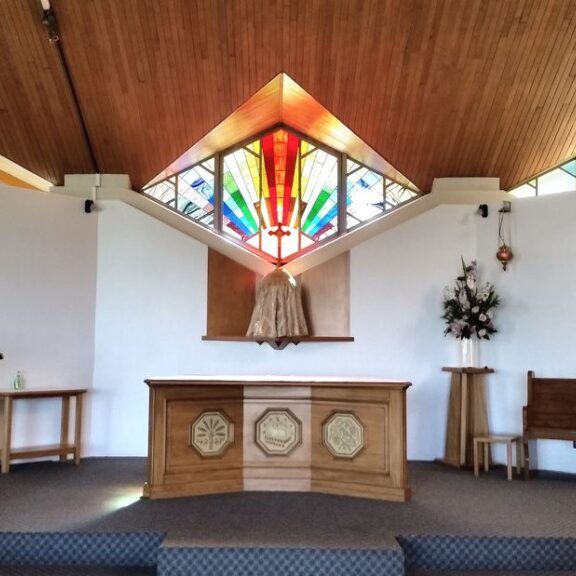
This is the sanctuary of our church, from where the celebration of Mass is led.
The three main items of furniture are: -
- the Altar; now often called the Table of the Eucharist. This altar is from the chapel at Star of the Sea school in Granger Road, and adapted by Father Peter Prendergast. The front panels show wheat, the Paschal Lamb on top of the book with seven seals
- on its left is the Lecturn; now often referred to as the Table of the Word, from which the scriptures are proclaimed
- on its right is the President's Chair, from which the priest presides, the symbol of the presence of Christ in our midst
Above and behind the Altar is the Tabernacle, containing the Blessed Sacrament, the consecrated Bread whitch is the Body of Christ.
Look further down for an explanation of the window above the altar.
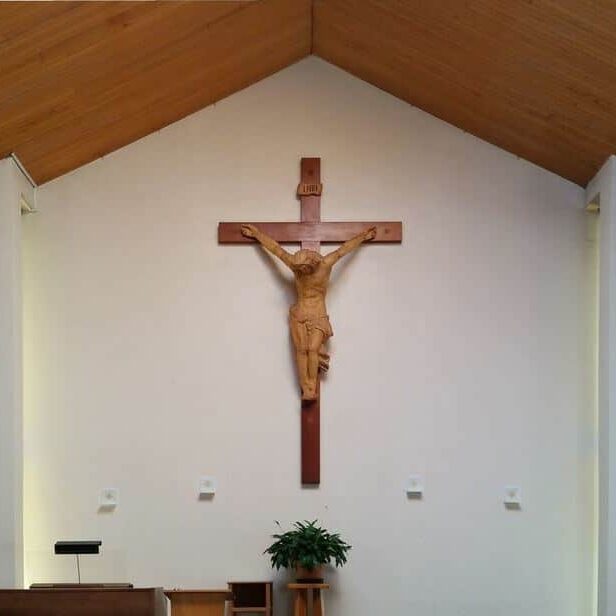
The crucifix dominates the north wall, reminding us all that the death and resurrection of Jesus is the centre of our faith. Beneath the crucifx are six of the twelve lampstands that were installed when the church was dedicated.
This area is where the sanctuary used to be. The marble altar which used to be here is now in the Lady Chapel.
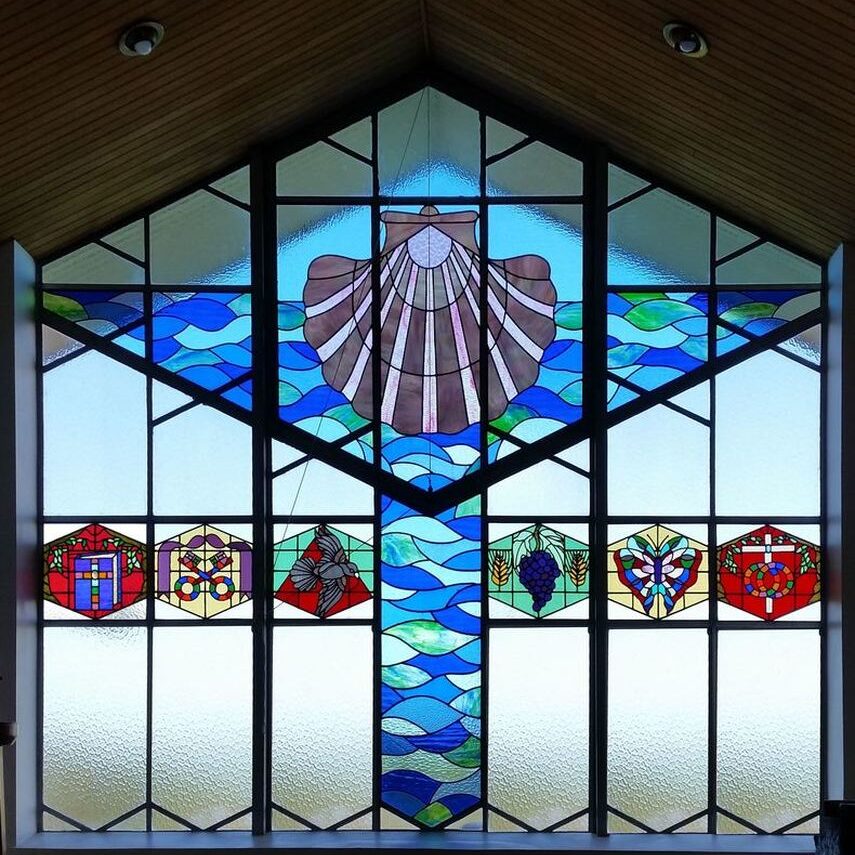
The panels of the window above the baptismal font represent the seven sacraments.
They were designed by Ann Purchase and made by Sonja Spellers of “Glasshoppers ”.
- In the centre the big shell pours out the waters of Baptism. It is the first sacrament we receive; it cleanses us of Original Sin, makes us officially children of God, and members of the Church with all the privileges and obligations that involves.
Starting from the left: -
- Holy Orders - Ordination to the Priesthood
The book represents the preaching of the Bible,
and the Missal. - The Sacrament of Reconciliation
- Represented by the purple stole worn by the Priest when hearing confession, the colour purple shows the sorrow and the remorse we feel for the sins we have committed.
- The keys are the sign of forgiveness opening again for us the gates of heaven. - The Sacrament of Confirmation
- It gives us the strength to profess our Christian Faith with the help of the Holy Spirit.
- It officially sends us out to spread the Good News of the Gospel.
- It is represented by the picture of a dove. - The Holy Eucharist
Symbolised here by wheat and grapes for the bread and wine, which we believe become the Body and Blood of our Lord Jesus Christ through transubstantiation at the Consecration at Mass. - Anointing of the sick and of the dying
For the sick the hope of being cared for, the dying the hope of a new life, both symbolised by the butterfly. - Holy Matrimony - the Sacrament of Marriage
- In front of the Priest representing the Church, the bride and groom make the solemn promise to share their lives,
- the rings are a symbol of the solemnity and eternity of this promise.
- The Cross reminds us of the obligations of the Christian Marriage which St Paul compares to the union of Christ with his Church.
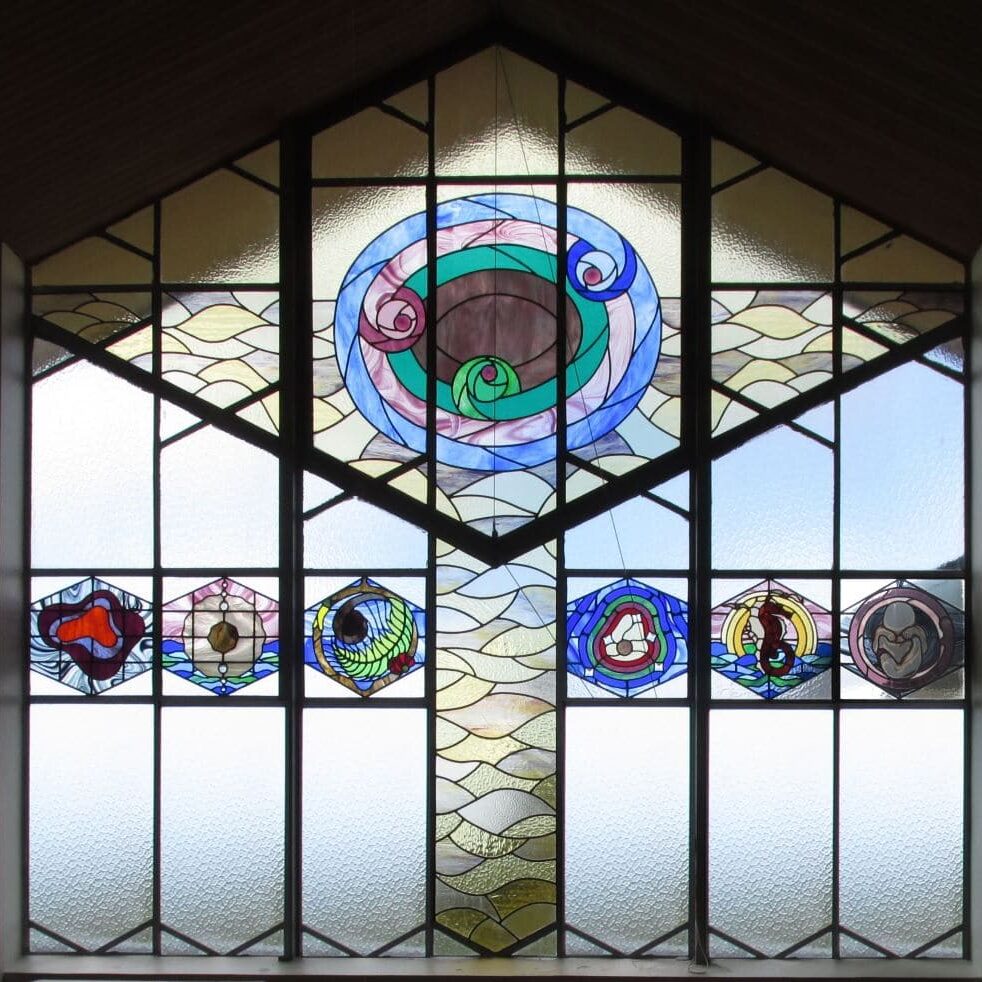
The panels depict the Days of Creation as described in Genesis, the First Book of the Bible.
In the centre:
- GENESIS 1:2 - “God’s spirit hovered over the waters”
The great egg shape with its three points represents the Holy Trinity in all its mystery and wonders, hovering over the waters - the Father is there
- the creative Word is there
- the Spirit of God hovers over the waters of chaos, bringing order and creation
Starting, from the left-hand side:
- GENESIS l:3-5:'God said: "Let there be light" and there was light'.
The earth was a formless void covered in darkness, God created the light and separated it from darkness - giving us day and night
... the first day. - GENESIS 116-8: “God separated the waters from the land.
... the second day. - GENESIS 1:9-13: The earth and its vegetation are created.
The panel shows our own native plants: the koru fern, the nikau
palm, the kowhai flower, the pohutukawa.
... the third day - GENESIS 1:14-19: God created the lights of heaven: the sun, the moon and the stars.
The sun. to illuminate the day, the moon and the stars. to shine at night.
... the fourth day. - GENESIS 1:20-23: God created the living things of the sea and of the air: the fish and the birds.
We have the picture of a seahorse, an ancient symbol of all that is wondrous in the animals of the sea ... and the picture of some birds flying in the sky
... the fifth day - GENESIS 1:24-31: God created all the creatures of the earth
and last of all He created man and woman in his own image.
The panel shows a baby in the womb, awaiting birth.
and God found it very good. - ... the sixth day
- Heaven and earth were completed.
God blessed the seventh day and made it holy because on that day He rested after all his work of creating
(Genesis 2:1-4)
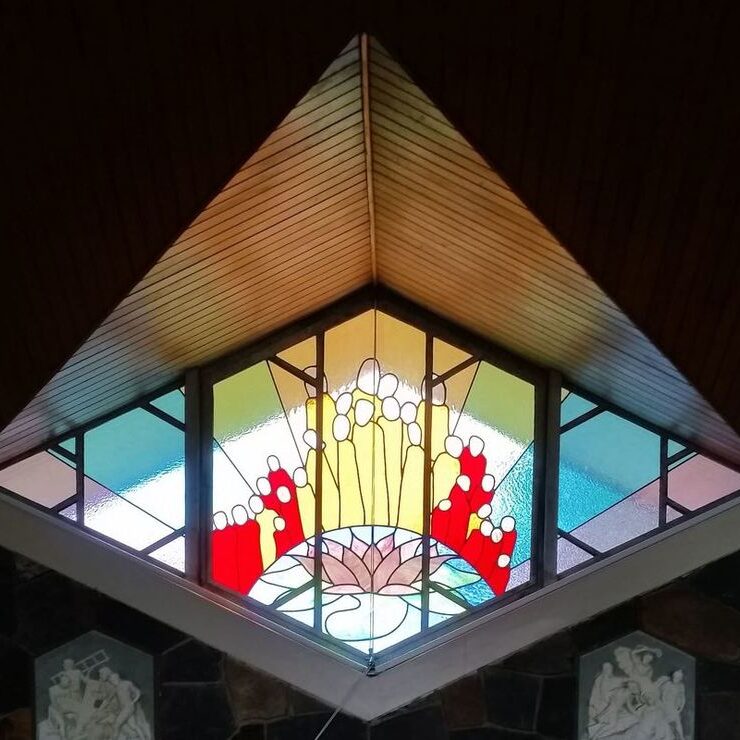
Memorial window for Colleen Weir.
Colleen’s life in our parish was centred around the youth, represented by the figures dressed in gold, and the children’s choir symbolised by the figures dressed in red.
Made by Sonja Spellers in conjunction with Jim Weir and assistance and advice from Ann Purchase.
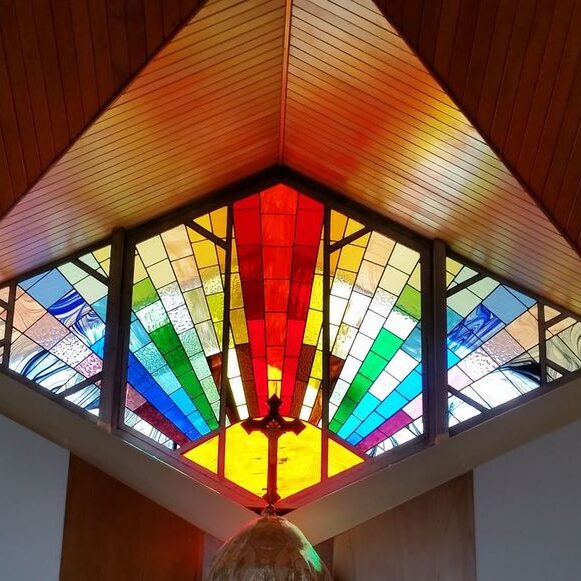
The window above the altar.
It represents the rising sun and recalls a prophecy fiom the Old Testament: -
“From the rising of the sun to its going down My Name will be great among the Gentiles and in every place a perfect sacrifice will be offered for the honour of my Name.” (Malachi 1:1 1).
That prophecy has come true because throughout the world, at some time or other and in some place or other the Sacrifice of the Mass is being offered for the praise and the glory of God.
This window was designed by Richard Williams and made by Robert Patching of “Past Joys”.
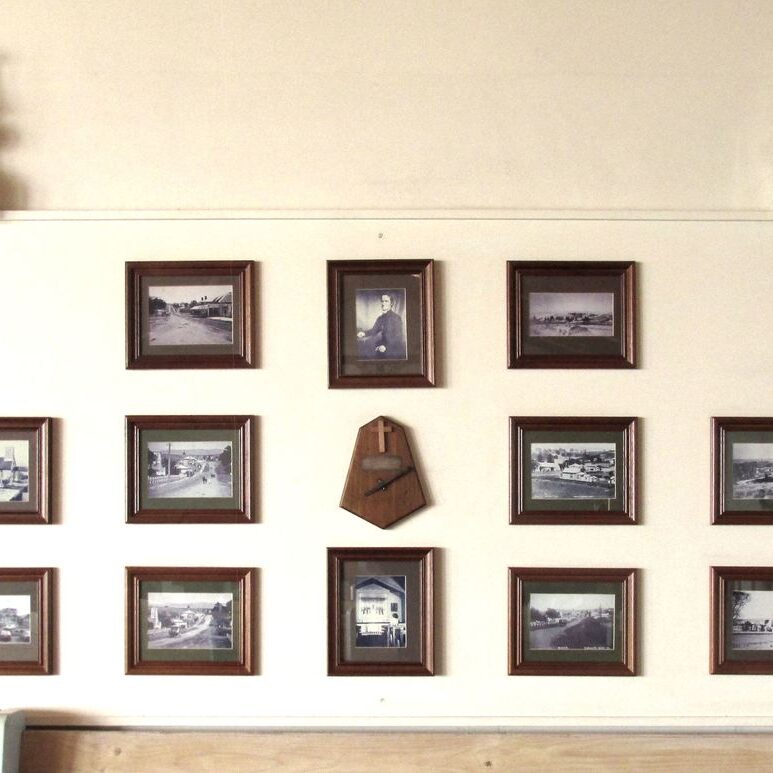
These are various historic photos from the early days. Father Garin is in the centre of the top row. The photo on the right of the top row - taken in 1863 - is the only known photo of the church with the original steeple. That steeple was struck by lightning and had to be demolished.
In the centre is one of the nails from the old wooden church.
The finials are also from the old church.
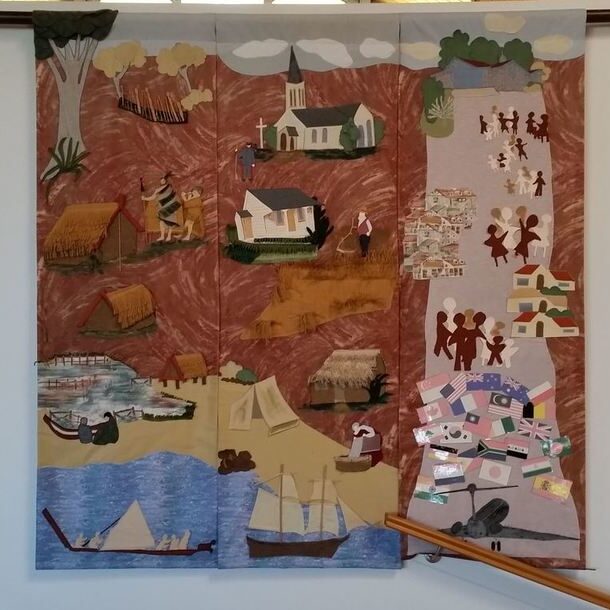
Many banners were made by Louise Nobel-Campbell over the years.
This one depicts the various waves of immigrants to Howick.
First came the Maori in canoes; they lived in simple huts.
Next came the Pakeha in sailing ships; they lived in tents and other temporary shelters to start with but eventually lived in wooden houses. Iron provided them with possibilities the Maori didn't dream of.
More recently new immigrants came in planes from all over the world and lived in much more modern houses.
The three Rosary windows were designed by Ann Purchase and made by Sonja Spellers of “Glasshoppers ".
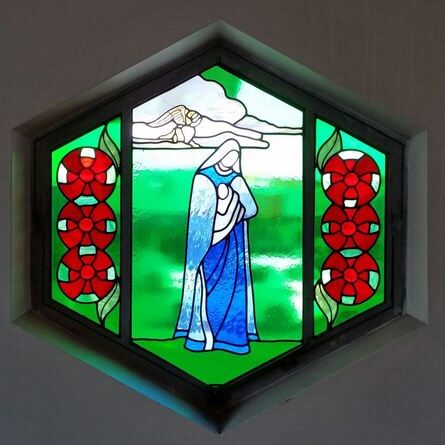
The first window symbolises Christmas.
Mary, dressed in blue, holds the infant Jesus in her arms. Full of grace, she has eyes only for him. 'His mother stored up all these things in her heart' (Luke 2:51).
The outline of an angel can be seen in the sky.
The background is green, the colour of hope.
The flowers are those of the pohutukawa tree normally in full bloom at Christmas.
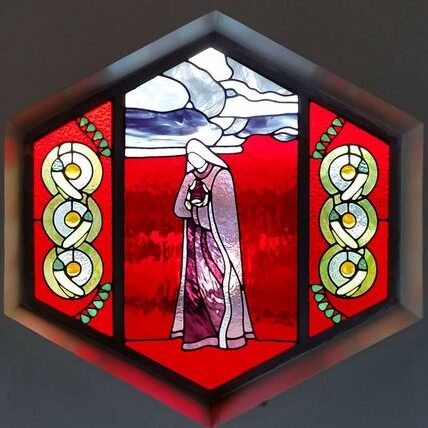
The middle window represents “Our Lady of sorrows”
Dressed in purple, Mary meditates on the suffering her Son will endure.
Her pain is depicted by the thorns around her arms.
The background is red - for the blood Christ will shed on Calvary.
The sky is sombre.
The flowers are the blooms of the Kowhai.
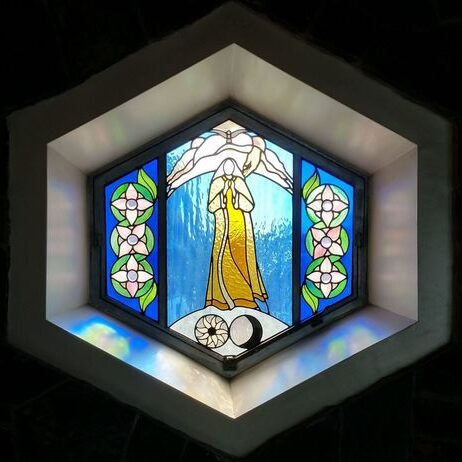
The third window shows Mary as “Queen of Heaven”
She is dressed in gold, her head now lifted up in glory. The hand of God welcomes her, the Holy Spirit in the shape of a dove, hovers over her. The sun and the moon are at her feet (cf Revelations 12:1).
The background is blue, Our Lady's colour.
The flowers are wild roses.
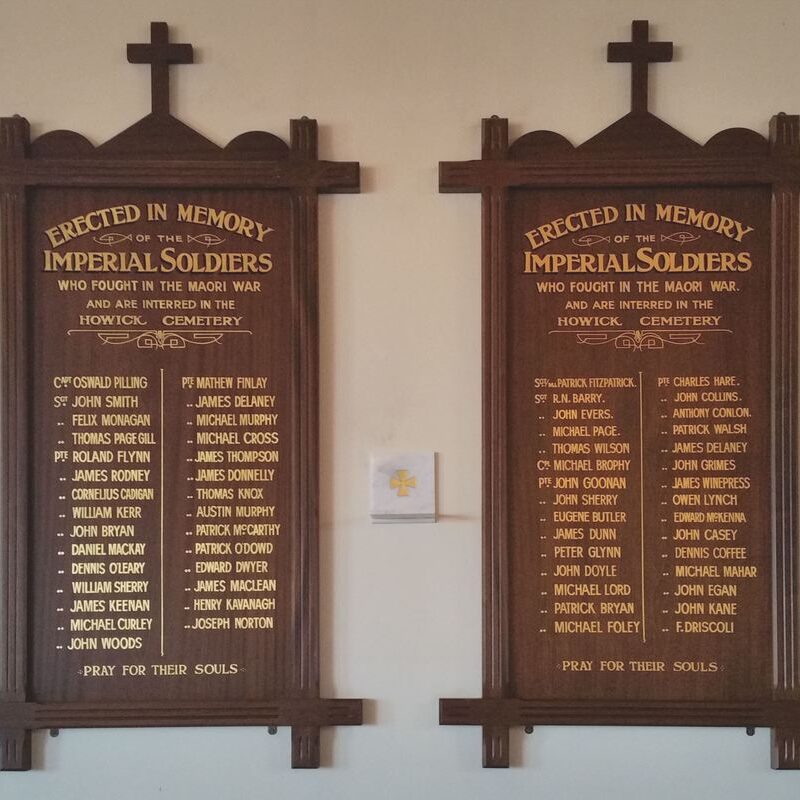
These two memorials commemorate Imperial Soldiers who are buried in our cemetery. The list is not complete: there are other names, for instance, on another plaque in the cemetery. These two lists overlap but are not the same, and a few names have different ranks on each memorial. The sources of these lists and the site of most of the graves is unknown.
When the original wooden church was replaced with a stone one, there was no room on the walls for the plaques, which were offered to the Howick Historic Village, where they are today. The present plaques are replicas that found a place in the church when it was enlarged.